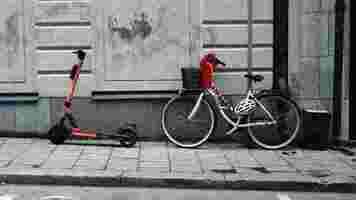Hey America, stop buying hybrids: They’re BAD
Last week, with the help of Will Ferrell and GM , America threw down the gauntlet to electric vehicle lovers Norway, and vowed to “catch up.”

It seems the US has already sorta kinda got the message, except it’s buying the wrong type of vehicle.
According to figures from automotive market analyst Tyson Jominy at JD Power, the number of hybrid vehicles sold in the US is growing faster than the sale of plug-in hybrids (PHEVs) and battery electric vehicles (BEVs).
It’s understandable that hybrids are winning, though. If the country’s EV charging network was better, I’m sure more would gravitate to pure EVs. Build it and they will come.
Since September last year, sales of BEVs and PHEVs have stagnated, showing no signs of growth. Sales were growing steadily since last May, but then tailed off.
However, the sales of regular ol’ hybrid vehicles have been slowly but surely heading upwards. Chart goes up, that’s good right?
Well, yes and no.
It’s great that sales of this type of vehicle are increasing. It demonstrates people are making a conscious switch to vehicles they believe to be less polluting. Unfortunately, they’re buying the worst kind of electrified vehicle possible.
Speaking with broad sweeps of the brush, hybrids are better than pure gasoline cars, PHEVs are better than regular hybrids, and BEVs are the king of the crop.
However, both regular hybrids and PHEVs have been found to fall short of manufacturer claims and can be far worse for the environment than drivers have been led to believe.
The reality is that hybrid vehicles are only marginally better for the environment in terms of emissions than gasoline equivalents. They also come with a larger environmental hangover of having not just combustion engines, but also containing batteries and motors, which are constructed from expensive and difficult to mine earth metals.
Producing a hybrid vehicle takes more energy and materials than producing a gasoline car.
As a result, hybrids take longer to offset their production emissions than EVs, and when they do, they are still pumping gaseous baddies out of their tailpipe.
A typical EV offsets its production emissions within 16 months of ownership, and when it has, it doesn’t continue polluting the world from its tailpipe — because there isn’t one.
Clearly, America is making an effort, and that’s good. But it needs to buy more EVs, and skip over the hybrid technology, which is just that: a stepping stone to EVs.
If Will Ferrell and GM are really serious about electric cars, they should also make sure there are charging points everywhere in the country, if it’s truly going to beat Norway at its own game.
SHIFT is brought to you by Polestar. It’s time to accelerate the shift to sustainable mobility. That is why Polestar combines electric driving with cutting-edge design and thrilling performance. Find out how .
Charging stations vs battery swaps: What’s better for micromobility?
This article was written by Juan Btesh on The Urban Mobility Daily , the content site of the Urban Mobility Company, a Paris-based company which is moving the business of mobility forward through physical and virtual events and services. Join their community of 10K+ global mobility professionals by signing up for the Urban Mobility Weekly newsletter . Read the original article here and follow them on Linkedin and Twitter .

One of the pain points of micromobility operators is to figure out how to keep their dockless fleet charged and available to use. When it all started, this was carried out by gig economy workers who collected a couple of dead scooters and took them to their homes to recharge overnight on their own power supply. While this scheme is still being used by some providers, new solutions were needed when operations started to grow, service became formalized and cities imposed stricter regulations for companies to be responsible for their scooter clutter instead of depending on freelancers.
The battery -recharging scheme evolved to the next level when mobility providers undertook recharging operations in-house or even outsourced this business to third parties. Trucks and vans started being piled with a larger amount of scooters that were driven to hubs and warehouses for recharging and maintenance. This model still requires combustion vehicles doing the job at a limited capacity and makes the scooters unavailable for several hours while they are taken to recharge, reducing the opportunity for generating revenue. The current battery-charging scheme is difficult to scale, unreliable, expensive and unsustainable.
Truth is that the problem persists, there is currently lack of charging infrastructure, and different players are working towards two possible solutions: the universal charging station and the universal battery swap .
We are already familiarized with EV charging stations, as electric cars rely on a dense and ubiquitous network of ECS where users can leave their vehicle charging while parked. These are nowadays not entirely suitable for micromobility vehicles, such as ebikes and escooters, as they have different power and amperage requirements, as well as different connectors and parking infrastructure needs.
New players and industry leaders are working to develop a charging station specifically designed for micromobility that can meet the needs of these vehicles. PBSC is one of them, and they promise to organize, secure, and charge electric vehicles, all while reducing operating costs. Swiftmile offers a solar-powered station with innovative digital displays that provide public transit info, traffic alerts and generates revenue through ads.
Peter Deppe is the Co-Founder and CEO of Kuhmute , a modular and universal charging station aimed at micromobility. Their business model consists in either charging a monthly subscription fee per vehicle to mobility operators or in selling the customizable stations to shops and convenience stores. It also allows individuals to take their privately-owned scooter and charge it (and lock it securely) at a per-minute rate.
A universal micromobility charging station is a mix between a “gas station” and gated parking where you can charge up your escooter, ebike or autonomousdelivery robot and feel safe knowing your shared or owned vehicle is locked.
A great advantage of this solution is that it not only provides charging power, but also parking and locking service. This prevents vehicles to be vandalised and stolen while keeping the city clean and tidy, avoiding accidents for pedestrians caused by e-scooters scattered across sidewalks.
So can I charge any e-scooter or e-bike on this station? Well, you will need a special adaptor, as not all vehicles are designed by the same manufacturer so you will need a special device to hack compatibility. Estonian start-up Duckt is also aiming at docking, locking and charging infrastructure solutions for micromobility in urban environment and developed their own adaptor for e-scooters.
Regarding waiting time, universal charging stations can top-up your battery in 3 to 6 hours but there is still lots of room to improve efficiency as it happened with EV superchargers.
What if instead of waiting for vehicles to be charged at the station we could swap depleted batteries for charged ones? This is the universal battery swap concept and it fits perfectly for e-scooters and e-bikes as they have smaller, easier to handle batteries in comparison to cars. The swapping model can be implemented by hiring a battery swap team or by deploying stations across the city and assigning the battery swap task to the user through incentives.
The main advantage here is the waiting time, as the battery change can be completed in less than a few minutes. The swap-and-go scheme not only eliminates the annoying delay but also maximizes vehicle uptime, extending the available hours of revenue-making for operators. Another important benefit is that the vehicle doesn’t need to be carried anywhere to be recharged. You can transport only the battery and change it in situ, optimizing the process by reducing unnecessary recharging trips.
The main company behind this project is Gogoro , which came up with these solution a couple of years ago, initially aimed at mopeds. They currently have a network of 1900 stations across Taiwan with that complete 200,000 battery swaps a day. In Europe, Tier partnered with Okai scooters to develop a solution and is planning on implementing it soon , starting in Paris. Their charging cabinet is ideal for small convenience stores and cafes, and they will cover for the electricity cost, benefiting users with a 15-minute ride for swapping the battery and shop owners by increasing customer traffic to their business.
Both of the presented alternatives solve the recharging problem effectively by reducing costs for the operators, in a sustainable way, with positive externalities for users. However, each one has unique advantages that can be used in different situations. The goal of the discussion is not to select a winner, but to evaluate in which circumstances or context we could find each of them more convenient. While the clear advantage of the swapping stations is to be fast and focus specifically on the battery instead of the whole vehicle, the stations can provide parking and locking to vehicles fighting against vandalism and guaranteeing clear streets. Other important aspects are highlighted below:
Charging docking stations require a much larger infrastructure investment and limit where riders can take the vehicles. Instead, battery swap cabinets can fit in any convenience store and have a plug-in-plug-out system which makes them much more cost effective in terms of space needed and do not necessarily require use of public space.
Why would a user take responsibility for swapping a battery of a shared vehicle? Why would someone modify their destination point to dock the vehicle in a charging station? The answer is through user incentives, and they can be applied to both of the described schemes.
Tier offers a free ride for a battery swap and Kuhmute offers a free unlock if the vehicle is docked in one of their stations. Although this incentive is a starting point, there is room to develop a system in which a variable amount of money is transferred in form of credits to the user that would depend on the level of charge of the battery.
Users need to be participated through incentives to effectively run the recharging scheme in a true shared economy business model. The other benefit of this strategy, particularly for the charging stations, is that incentives can also nudge users to drive towards areas where more vehicles are needed, and therefore help balance the operator’s fleet.
In the 1890’s Thomas Edison worked on developing a battery that would make electric cars the preferred transportation mode over gasoline and steam. His goal was to patent and become the industry standard, with his firm being the main battery manufacturer and vendor. He patented an alkaline based nickel–iron battery in 1901 but users found it had a short battery life, performed poorly at low temperatures and was more expensive than the existing lead-acid cell. A few years later Edison was able to produce a more lightweight and durable model but by this time the inexpensive and reliable Model T Ford had made gasoline engine cars the standard. Edison was disappointed that his battery was not adopted, and electric vehicles went out of production only a few years after his battery was introduced.
Battery swaps necessarily need universal batteries with a single design that are adopted by every operator, otherwise they wouldn’t really be universal and would make users wander around town trying to find the right cabinet for their battery. If all vehicles need to have the same type of battery, there is a risk of creating a huge monopoly through a single patent-owner manufacturer, such as Edison imagined back then for his own profit. This will typically make billionaires like Elon Musk even richer and can be very disadvantageous for users. Monopolies block competition, prevent new players from joining the market, stagnate innovation, and might abuse users by setting above market prices or neglecting quality.
Monopolies in the mobility environment should be prevented with open-source technology or public intervention, so solutions are built for the common good.
The fact that a unique battery needs to be adopted massively brings another kind of problem. When an upgrade is given in the charging technology or in the battery type (more durability, smaller volume, or lighter weight) it will be very hard to implement, as it will require to replace all of the batteries that are already out there for new ones. This will need a reconfiguration of all of the stations and even vehicles, which were designed for the old technology, and will very likely result in lots of junk scooters and obsolete batteries.
Tesla finally has an office in India — but don’t expect its cars for a while
It has happened, Tesla has registered an office in the southern city of Bengaluru in India.

As per a filing in Registrar of Companies (RoC), the corporation is named Tesla India Motors and Energy Private Limited, and David Jon Feinstein, global senior director at Tesla, and Vaibhav Taneja, chief accounting officer at Tesla, are listed as part directors.
But before we get our hopes up, this move just means that Elon Musk’s celebrated car company intends to get a foothold in India. However, it might be a while till we see its shiny cars on road.
In December, India’s transport minister, Nitin Gadkari, said that Tesla will arrive in India sometime in 2021 . The minister said that the EV company will set up sales centers in the country and even explore opportunities for manufacturing cars.
Tesla will have to first set up its supercharger network in India before starting to sell its cars, and given the road congestion and traffic, it won’t be an easy task. To overcome that challenge, the Indian government plans to install EV chargers across 69,000 petrol stations in the country .
Last October, Musk had also said that it’ll launch the company in India in 2021. Well, technically it has arrived in the country now.
India’s electric vehicle market has been largely dominated by two-wheelers. In the financial year 2019-20 , 150,000 two-wheelers EVs were sold as compared to 3,400 four-wheelers. So it won’t be easy for the EV giant to get a foothold in a price-sensitive market.
Tesla is planning to make its most affordable Model 3 in the country by 2022 financial year . However, due to high custom duty rates for imported cars , it could cost anywhere between ₹55 to 60 lakh (roughly $75,000) — more than double what it costs in the US.
For now, we’ll have to see if the company makes any solid promises about delivery dates and the charging network this year.
SHIFT is brought to you by Polestar. It’s time to accelerate the shift to sustainable mobility. That is why Polestar combines electric driving with cutting-edge design and thrilling performance. Find out how .